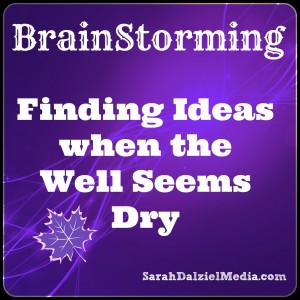Possibly the most dreaded happening in any creative life is the day you wake up with no ideas. The blog needs writing, or the story needs an ending, but where are the ideas? When that happens, I brainstorm.
How will Brainstorming help me?
Brainstorming helps in three different ways. First, it is a non-judgmental process so it frees the creative juices. Second, it can help you find relationships between unrelated topics. Third, you will end up with plenty of ideas, and the ability to generate even more ideas and topics.
Brainstorming Methods
My personal method is a variation on free-writing. I write down my keyword, topic, or subject in the center of a blank piece of printer paper. Using coloured pencils, or pens, I then write down any and every word that comes to mind in relation to that central word, and any word that comes from another word that I already wrote down. Once I’ve either filled the page, or run out of words to write down, I consider that brainstorming session finished.
After collecting my related words and ideas, I look for ways to categorize them. First I look for relationships in topic, subject, or idea. So when I brainstormed Brainstorming I ended up with some inspiration/creativity related terms, as well as different methods for brainstorming and key terms in relation to brainstorming like the phrase “anything goes.”
Method Two: Brainstorming via Mind-Mapping
Mind mapping is a brainstorming method where you write down a main keyword and then join other words to it as they occur. I find this method more difficult since you need to recognize relationships between words and terms, instead of being able to free-write them.
I find mind-mapping helpful for organizing information after brainstorming. It is also helpful for categorizing information presented in a lecture or course. The basic form for mind-mapping is drawing a “brain” with the center keyword or subject, then branching off and attaching sub-topics, then adding more branches attaching subtopics to the subtopics. A large mind-map can end up looking like a bunch of interconnected neurons, which might be why it is called “mind” mapping.
Method Three: Brainstorming via Creative Expression
A third brainstorming method that I have used is that of exploring a subject through creative expression. For me this usually takes the form of drawing, like drawing a storm cloud with a lightning bolt to represent brainstorming. However this method is not limited to drawing. You could take a subject, idea, or word and then go photo hunting to try and capture the idea. Another technique would be to look at a painting or photograph and write down the words, phrases, and ideas that that particular scene brings to mind. Music can also provide inspiration or ideas, or background noise for brainstorming.
Back to You:
What methods do you use to generate ideas, or expand on topics? Do you utilize brainstorming, mind-mapping, or another method? I’d love to hear from you, leave a comment.

Leave a Reply